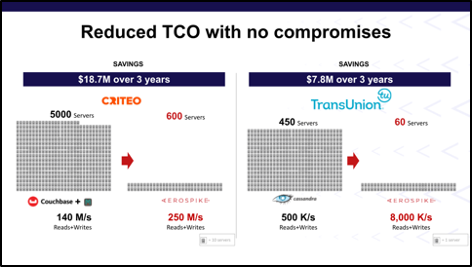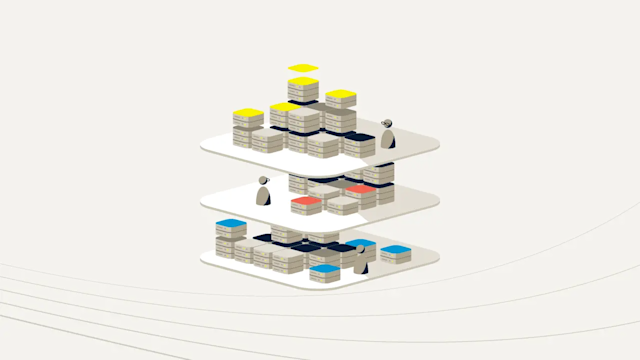If your business depends on real-time data and decisions at scale, your selection of an operational database deserves significant attention. The choice plays a big role in your ability to serve your customers and innovate, and it can set you on very different paths for your long-term database costs.
Maybe it didn’t seem like a big item when you were first getting started when your developers played with open-source versions or a free trial. And maybe when your CFO or CIO saw that first monthly, quarterly, or even annual bill, it didn’t seem like a big line item among all your focus areas. Or perhaps it’s growing more noticeable now. Either way, that single database software line item is typically just the tip of the iceberg of the total cost.
You may feel like you have selected the right database, but keep in mind its benefits should far exceed its total cost of ownership (TCO). But if you have a sinking feeling that your database is a money pit or even suspect so, read on and look in these five areas where you might be getting fleeced.
#1: Database license costs – (hint: if they’re growing as fast as your data, or faster)
Before we get into some of the more hidden costs, let’s take a look at the most obvious sign, the bill from your database vendor. It’s often pretty easy to get started inexpensively with a database. In fact, you may have said, “Database X will work for our minimum viable product (MVP) or for the first few quarters. If the product works and customer demand follows, that will be a good problem to have.”
Congratulations – you’ve grown, and now you have that problem!
Unfortunately, the architecture and the pricing structures of many databases do not scale well. The RAM behind in-memory databases doesn’t benefit from economies of scale. Doubling the RAM will double your database bill, but it won’t double your performance. A database architected for scale, on the other hand, experiences almost no performance dropoff with workload growth.
You may also find that even your “database software” bill isn’t as simple as when you started. In fact, you may be accumulating databases – one for key value, one for document use cases, one as a cache, another as a source of truth, etc.
Consider a vendor with a multi-model database that can handle use cases from cache at the edge to a system of record at the core to avoid this database sprawl.
#2: Your database costs are hiding on your infrastructure bill
“Okay,” you say, “I found all my databases and database vendors and looked at all the line items. Isn’t that the full cost of the database?”
Nope! Hint – there are 4 more spots to check. If we lived in a world where only software license costs mattered, then an easy conclusion would be to only use open-source software. (And this blog would have ended at #1.) You probably know by now, though, that open source is far from “free.”
You may think of databases as just software, and maybe software did eat the world, but hardware and other infrastructure often have the bigger appetite on your budget. Whether you own and manage your own data centers or run entirely in the cloud, leaning on hyperscaler infrastructure and SaaS offerings, your databases can have a huge variance in their infrastructure requirements and the associated costs.
Two separate databases may deliver the same low latency, same throughput, and the same list price but have very different implications from a server, storage, and networking infrastructure perspective.
Many database vendors use node-based pricing, so software license fees grow in step with hardware costs. This actually gives the vendor an incentive to saddle customers with an excessive amount of low-density servers based on inefficient in-memory architectures. To make matters worse, these in-memory approaches require more data copies (higher replication factors) and, thus, even more infrastructure.
Aerospike doesn’t price by node but rather by the data volumes under management. We can often deliver the same performance with 80% fewer servers or cloud instances than alternative databases at scale. Aerospike Hybrid Memory Architecture (HMATM) combines indexes in memory and data on SSDs for near in-memory speed at flash storage prices. The total cost difference can be jaw-dropping.

#3: Your database costs are hiding on your payroll
So, you found your database line items and all the associated infrastructure costs, maybe with a little help from your friends in accounting. You’ve got a full total cost of ownership of your database now, right?
Nope, not even close.
The next place to go looking for the costs of running your database is your staff’s time. How many database administrators, developers, SREs, data engineers, and others does it take to set up, manage, upgrade, and scramble to fix problems with your database?
Again, some databases are both inexpensive and easy to manage in your proof of concept (POC) or your minimum viable product phase. But very few databases scale without a lot of effort, ongoing support, and maintenance. For example, applications may require refactoring as they scale beyond the scope of the initial POC or the initial small deployment. You could avoid these costs with a database that extends from the desktop to terabytes to petabytes, all with the same architecture.
Some databases like Cassandra, while known for scaling, can lead to high server counts that require many engineers to support. There is a lot to be said for a database that just works, at scale. As PhonePe describes it, Aerospike “gives us everything Cassandra does, without requiring people to constantly care for it.” Even better, it lets them sleep at night.
These costs again vary depending on if you are running your own data centers or in the cloud. Self-service or managed service cloud database offerings provide an option for organizations to limit database staffing costs and get out of the business of database management.
Either way, if you have a growing staff managing your databases, it may be a third red flag that your databases are costing you too much.
#4: Downtime – the opportunity cost of running your business
The next place to look for hidden database costs is downtime. Admittedly, these are getting harder to measure and harder to fit into your TCO spreadsheet. We didn’t say these signs were going to be easy to find and quantify.
Can your business afford a database that can be down for hours, minutes, or even seconds? If the answers are “no,” “no way,” and “no how!” you may be the kind of company that already can put a price tag on downtime.
If your website can’t serve up the best customer offer (let alone take a transaction), if you miss a few minutes of real-time advertising bids, or if you let fraudulent behavior get through because your database wasn’t available for a couple of seconds, your business can be out millions of dollars.
Remember the minimum viable product approach that saved you time or money on your initial database purchase? Remember that hypothetical “good problem to have” of growth and wondering if your database could scale with it? Well, the reality is there are few databases that truly scale and even fewer that do so without major refactoring. Many databases can’t migrate past cache-only use cases.
If you are experiencing downtime or you’re constantly re-configuring your database to avoid it, make sure to include that in your total database costs. Better yet, be sure to factor it into your initial decision, looking at vendors’ true record of uptime at scale.
#5: Your competitors are beating you
We are in a tight, uncertain economy. That’s why so many organizations are taking a closer look at their bottom lines and costs across the board.
That said, the fifth and final place your database might be costing you is actually on the top line – your ability to grow by helping existing customers and reaching new customers with your product.
This can be another hard one to find and quantify. The cost of being 100 milliseconds slower than your competition might be harder to measure than the cost of downtime, but it can meaningfully reduce your top-line revenue. LexisNexis Risk Solutions, for instance, knows their customers would shut them off at a certain millisecond range, say, 300 milliseconds.
Having a database that can generate sub-millisecond responses with millions of transactions per second (TPS) can open up broad new revenue streams and products. A leading brokerage has been able to run its risk model every few minutes rather than once a day, widely improving and expanding its margin lending practice.
So yes, scrutinize all the hidden costs that come from your database choice. You may get through this and be frustrated by all the costs of your database, but decide it’s not the time to invest in switching. Keep in mind, though, that your competition may have a scalable, real-time database with better uptime at a lower cost. And they may just out-innovate you and serve your customers better than you can.
This may not be the first place you look, but it could be the biggest cost of sticking with your existing database.
Choose the best database at the right TCO
Ultimately, most purchase decisions come down to the benefits the product delivers versus the cost. The advice of this blog is not to just focus on the cost side of the decision but rather to have open eyes about the true cost of a database. This is especially true as your needs change. And while more buyers are scrutinizing their costs in today’s economy, ultimately, your business is about delivering value for your customers better than anyone else can. The right database is the one that delivers on that – today and tomorrow – and doesn’t cost you an arm and a leg when you add up the true total cost of ownership.




